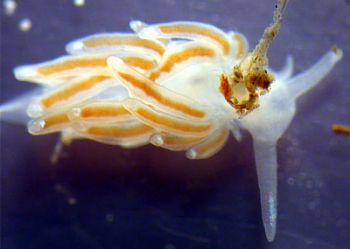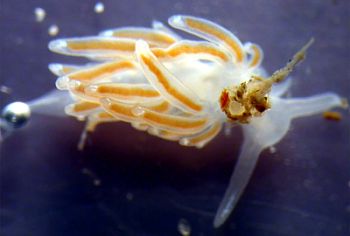Juvenile Flabellina from Sweden
December 19, 2001
From: Mike Noren


The following sea slug was collected recently on the Swedish west coast, at Tjärnö, probably from a sample of red algae with a lot of assorted epifauna collected from 8 - 15m depth. It was about 4mm long.
Sorry about the rhinophores - I tried to remove the debris which had stuck to them, but I would have ripped the slug before getting rid of it. Best guess here is Flabellina nobilis or Flabellina browni.
Incidentally, isn't there a lot of virtually identical species in the Flabellina / Coryphella genera, or is it just me?
Mike Noren
mike_noren@hotmail.com
Noren, M., 2001 (Dec 19) Juvenile Flabellina from Sweden. [Message in] Sea Slug Forum. Australian Museum, Sydney. Available from http://www.seaslugforum.net/find/5830Dear Mike,
I asked Bernard Picton and Jussi Evertsen, who jointly prepared the key for North Atlantic species of Flabellina, to have a go at identifying your photo. I have put their replies below. As you can see, it seems a bit difficult to identify them from photos when they are so small. Concerning your question about too many species. Although some species are difficult to separate on general body shape and colour, there are good distinguishing characters to be found in the internal anatomy (including the radular morphology), and probably in aspects of their natural history (food, development time, etc.).
•Comment from Bernard Picton [bernard.picton.um@nics.gov.uk]:
Hi Bill - The Flabellina is a juvenile so very difficult to be certain. From the hefty oral tentacles and short broad-based tail I'd guess that it might be F. salmonacea, if the sender has located a place where there is a settlement of juveniles perhaps they can look again in the spring to see what they grow up into. - Bernard Picton
•Comment from Jussi Evertsen [jussi.evertsen@vm.ntnu.no]:
Hi Bill! - The image looks to me as if it could be a Coryphella, with the long
oral tentacles and distinct footcorners. Also the cerata seems to be arranged in transverse rows and in groups, which excludes species of Coryphella with cerata set one by one (gracilis), and with cerata set in continous rows (nobilis and so forth). Also the individual shown in the picture seems young. I could suggest this species to be either Coryphella verrucosa (rufibranchialis form) or a Coryphella browni as described by Bernard Picton. - Jussi Evertsen
Thanks Bernard and Jussi,
Bill Rudman
Related messages
-
Flabellina in the North Atlantic
From: Bernard Picton , July 28, 2001 -
Flabellina in the North Atlantic
From: Jussi Evertsen, July 28, 2001
